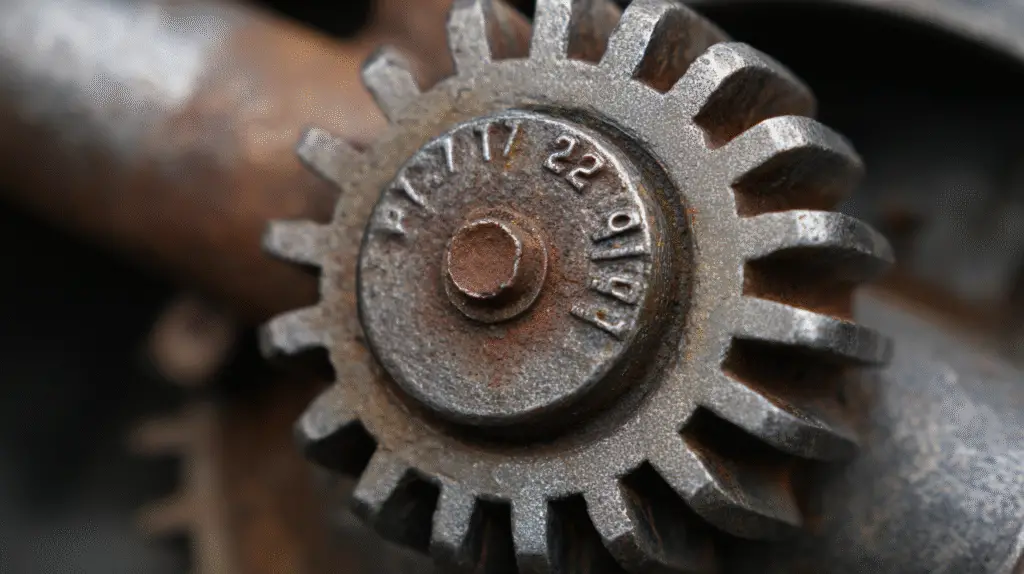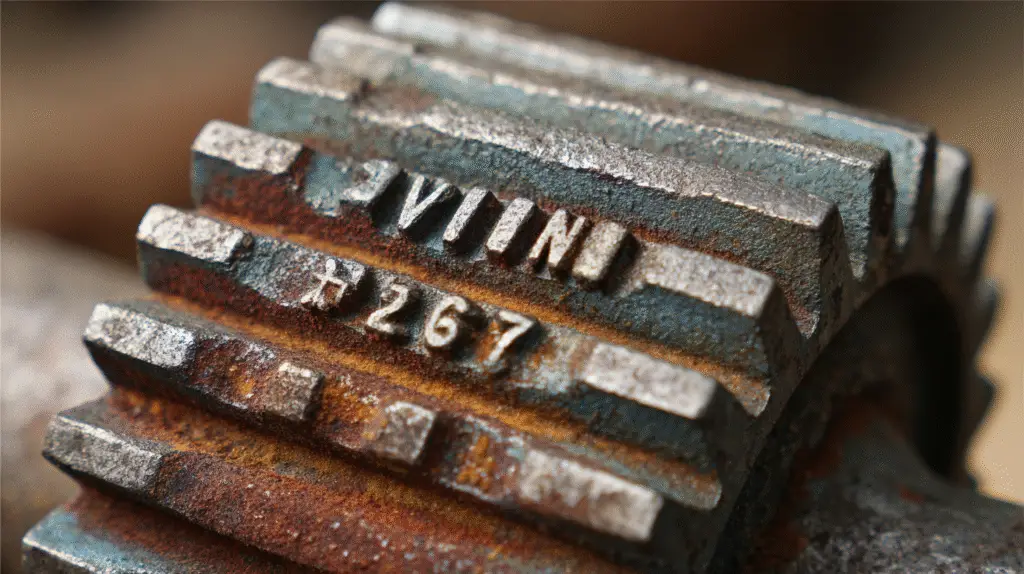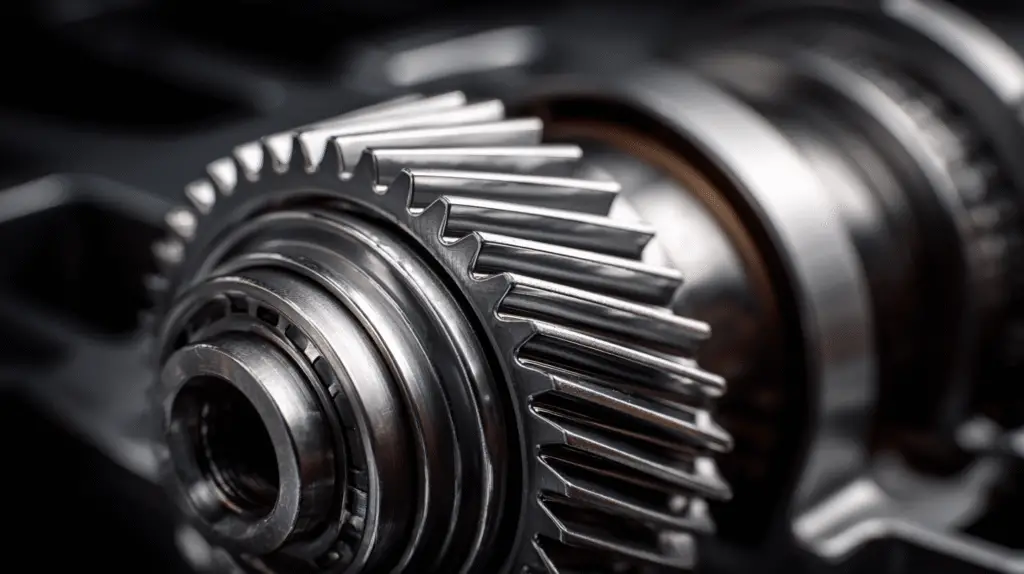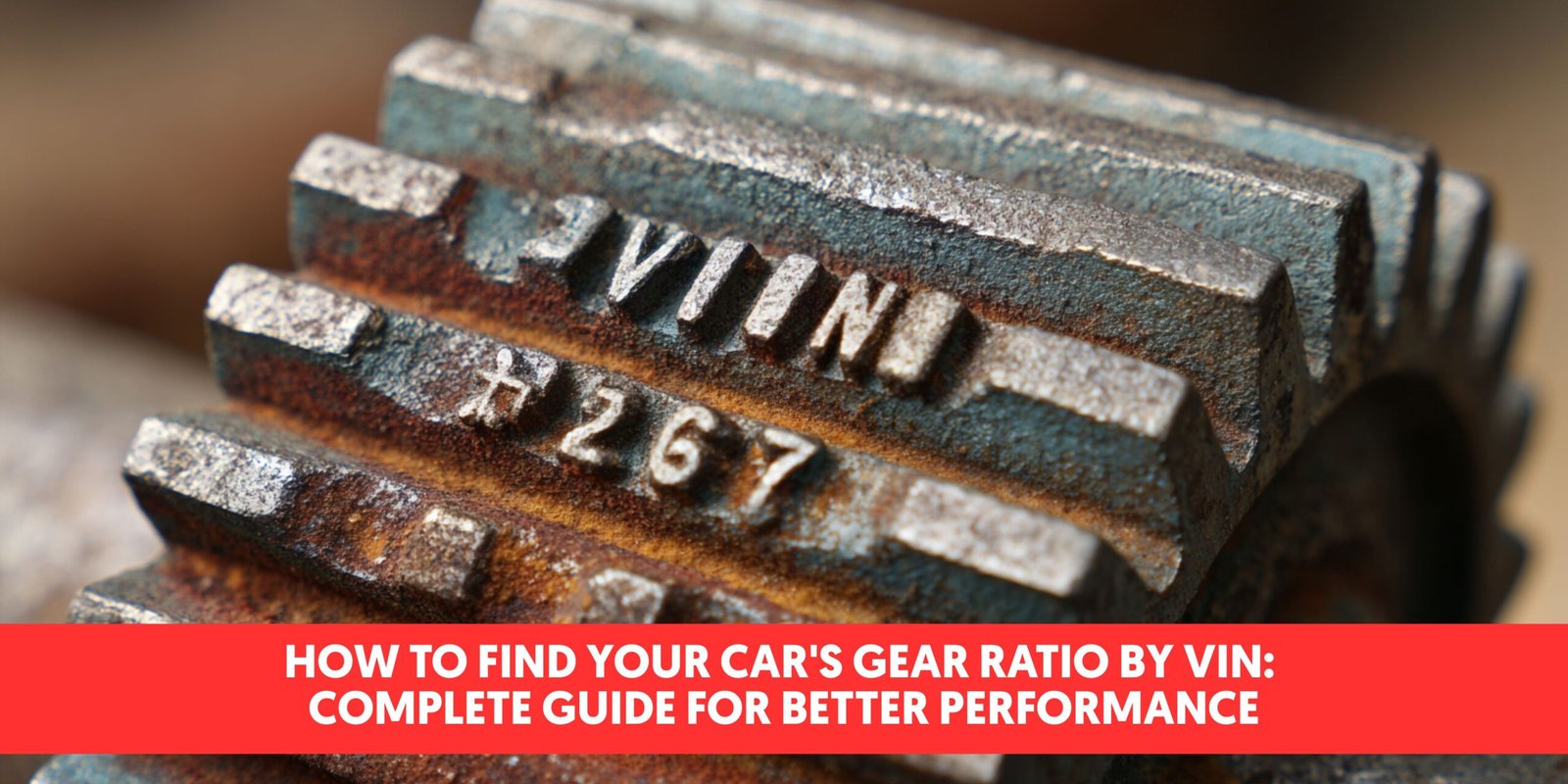Ever wondered how to find your vehicle’s gear ratio by VIN? This crucial piece of information can significantly impact your driving experience, fuel efficiency, and towing capacity.
Your Vehicle Identification Number (VIN) is the key to unlocking important specifications about your car or truck, including its gear ratio. Whether you’re planning to modify your vehicle, troubleshoot performance issues, or simply want to understand your car better, knowing how to decode this information from your VIN can save you time and prevent costly mistakes.
What Is a Gear Ratio and Why It Matters
A gear ratio represents the relationship between the number of teeth on two meshing gears, determining how many times the driven gear rotates compared to the driving gear. In vehicles, it’s specifically the ratio between the rotations of the driveshaft and the rotations of the wheels. This numerical relationship directly impacts your vehicle’s performance characteristics in several crucial ways.
Higher gear ratios (like 4.10:1) provide more torque multiplication, making them ideal for towing heavy loads or off-road driving where power delivery is paramount. Lower ratios (like 2.73:1) allow the engine to run at lower RPMs during highway cruising, improving fuel economy but reducing available torque for acceleration or climbing.
Your vehicle’s gear ratio affects:
- Acceleration performance: Higher ratios deliver quicker acceleration from a standstill
- Towing capacity: Steeper ratios provide enhanced pulling power for trailers and heavy loads
- Fuel efficiency: Lower ratios typically offer better highway fuel economy
- Engine RPM at cruising speed: Directly influenced by the final drive ratio
- Overall driving feel: The responsiveness and character of your vehicle
Understanding your exact gear ratio through your VIN helps when planning modifications like tire size changes or differential swaps. For instance, Liam Kohn recently helped a customer who installed oversized tires without adjusting his gear ratio, resulting in sluggish acceleration and poor fuel economy. After identifying the appropriate gear ratio for his vehicle and making the adjustment, the customer reported dramatically improved performance while maintaining reasonable fuel efficiency.
The factory-installed gear ratio represents an engineered compromise between performance, economy, and intended vehicle use. Manufacturers often offer different ratio options depending on package selections like towing packages or performance editions.
Understanding Vehicle Identification Numbers (VIN)

A Vehicle Identification Number (VIN) is a unique 17-character alphanumeric code that serves as your vehicle’s fingerprint. This standardized identifier provides crucial information about your car’s manufacturing history, specifications, and components—including potential clues about its gear ratio.
How VINs Are Structured
VINs follow a standardized format under ISO 3779 to ensure consistency across all manufacturers worldwide. The first three characters, known as the Industry Manufacturer Identifier (WMI), reveal the country of origin and manufacturer of your vehicle. Characters 4-8 comprise the Vehicle Descriptor Section (VDS), which details exact attributes like model, body type, and engine specifications. The ninth character functions as a check digit that verifies the VIN’s authenticity through a mathematical formula. Character 10 indicates the model year, while the eleventh character specifies the manufacturing plant where your vehicle was assembled. The final six characters (positions 12-17) represent sequential production numbers that uniquely identify your exact vehicle in the production line.
What Information a VIN Contains
Your VIN encodes comprehensive details about your vehicle beyond simple identification. The manufacturer and country of origin are immediately evident from the WMI section at the beginning of the code. Model and body type information is encoded within the VDS portion, helping you identify exact specifications without relying on visual inspection alone. Engine specifications are typically included in the VDS section, providing insights into displacement, cylinder configuration, and fuel type. Some manufacturers include transmission details within exact characters of the VIN, though this varies by brand. About gear ratios, the VIN doesn’t always explicitly state this information, but it often provides enough context about package options and specifications that dealers and manufacturers can determine the factory-installed ratio from their databases. For vehicles where gear ratio isn’t directly specified in the VIN, you’ll need to explore alternative methods such as inspecting the transmission, referencing the RPO codes on the service placard, or consulting manufacturer resources to identify your exact gear ratio configuration.
How to Find Gear Ratio Using Your VIN

Finding your vehicle’s gear ratio through its Vehicle Identification Number (VIN) helps you understand crucial performance characteristics without mechanical inspection. Your VIN contains encoded information that can reveal factory specifications, including the gear ratio in many cases.
Decoding the VIN for Axle Information
The VIN structure includes exact positions that may reveal axle and gear ratio details. Within the 17-character code, the Vehicle Documentation Section (VDS) spanning characters 4-8 often contains model, brand, and gear ratio information. Not all manufacturers encode gear ratios directly in the VIN, but those that do typically place this information in consistent positions within the code. Some American manufacturers, for example, include axle codes that correspond to exact gear ratios in their factory documentation.
Online VIN Decoder Tools
Online VIN decoders translate your vehicle’s complex identification code into easily understood specifications. These tools allow you to input your complete 17-digit VIN and receive detailed information about your vehicle’s original configuration, potentially including the gear ratio. Specialized automotive databases provide more accurate results than generic decoders, especially for detailed specifications like gear ratios. For best results, cross-reference information from multiple sources to confirm accuracy. If online tools don’t provide gear ratio information, contacting the manufacturer or an authorized dealer with your VIN gives you direct access to precise specifications from comprehensive databases. Dealerships can explain exactly how your vehicle’s gear ratio affects its performance characteristics.
Manufacturer-Specific VIN Decoding for Gear Ratios

While VINs contain valuable vehicle information, the method for identifying gear ratios varies significantly by manufacturer. Different automakers store this critical specification in unique locations within their databases, requiring brand-exact approaches to access this information accurately.
Ford Gear Ratio by VIN
Ford doesn’t directly encode gear ratios within the standard VIN structure. The Vehicle Descriptor Section (VDS), found in characters 4 through 9 of your VIN, contains some technical specifications but typically doesn’t explicitly list gear ratios. To find your Ford’s gear ratio, you’ll need to access Ford’s official VIN decoder or consult the original equipment listing. These resources are available through dealership records or Ford’s online tools, which translate your VIN into comprehensive vehicle specifications including the factory-installed gear ratio.
Chevrolet and GMC Gear Ratio Identification
General Motors vehicles (Chevrolet and GMC) link gear ratio information to Regular Production Option (RPO) codes rather than embedding it directly in the VIN. You’ll find these RPO codes on a sticker inside the glove box or in your vehicle documentation. The codes serve as keys to unlock exact information about vehicle options, including rear axle specifications and gear ratios. By entering your VIN into a GM database or official decoder, you’ll access the complete build sheet that lists the RPO code corresponding to your vehicle’s axle and gear ratio configuration.
Dodge and Ram Gear Ratio Codes
Dodge and Ram vehicles require using the Mopar VIN decoder or similar official lookup tools to identify gear ratios. Your VIN itself doesn’t contain the gear ratio information, but the build sheet generated after entering your VIN into these tools provides detailed equipment specifications. The Equipment Listing accessed through Dodge/Ram official websites after VIN entry clearly specifies the axle type and gear ratio installed at the factory. This manufacturer-exact approach ensures accurate identification of your vehicle’s original gear configuration without guesswork.
| Manufacturer | Gear Ratio in VIN? | Where to Find Gear Ratio |
|---|---|---|
| Ford | No | VIN decoder, equipment listing |
| Chevrolet/GMC | No | RPO code, VIN lookup, build sheet |
| Dodge/Ram | No | Official VIN lookup, build sheet |
Importance of Knowing Your Vehicle’s Gear Ratio

Your vehicle’s gear ratio significantly impacts its overall performance, capabilities, and efficiency. Understanding this specification helps you optimize your driving experience and make informed decisions about vehicle modifications or usage patterns.
Performance Implications
Gear ratios directly affect how your engine’s power translates to the wheels. Lower numerical gear ratios (like 3.21:1) prioritize fuel efficiency by keeping engine RPMs lower at highway speeds. Higher numerical ratios (such as 4.10:1 or 4.30:1) deliver increased torque, resulting in better acceleration and improved power delivery. The relationship between your engine and transmission becomes optimized when you select the appropriate gear ratio for your driving needs. Many performance enthusiasts modify their gear ratios to match their exact driving styles—whether that’s quick acceleration from stoplights or smooth cruising on highways. Your vehicle’s responsiveness changes noticeably with different gear ratios, affecting everything from throttle response to how quickly you reach highway speeds.
Towing and Hauling Considerations
Vehicles equipped with higher numerical gear ratios provide substantially more low-speed torque—a critical factor when towing trailers or hauling heavy loads. This additional torque makes starting from a complete stop much easier when pulling weight and improves your vehicle’s overall pulling power on inclines. The trade-off appears during highway cruising, where higher gear ratios typically increase engine RPMs, potentially reducing fuel economy during long-distance towing. Your towing capacity relies heavily on having the appropriate gear ratio; an incorrectly matched ratio can lead to transmission overheating or premature wear on drivetrain components. Many truck manufacturers offer optional towing packages that include higher numerical gear ratios specifically designed to handle the additional stress of regular towing applications.
Selecting the right gear ratio creates an optimal balance between performance needs and efficiency. This balance extends your vehicle’s lifespan by reducing unnecessary strain on engine and transmission components. Knowing your exact gear ratio through VIN identification helps you make smarter decisions about modifications, tire sizes, and how you use your vehicle for work or recreation.
Alternative Methods to Determine Gear Ratio

When VIN decoding doesn’t yield definitive gear ratio information, several reliable alternatives exist. These methods provide practical ways to identify your vehicle’s exact gear ratio through direct observation or mathematical calculations.
Visual Inspection Methods
Visual inspection offers hands-on approaches to determine your gear ratio with certainty. Counting teeth on the ring and pinion gears provides the most direct method – simply remove the differential cover, count the teeth on both gears, and divide the ring gear tooth count by the pinion gear count to find your exact ratio. This technique eliminates any guesswork from the process.
The driveshaft rotation method works effectively for vehicles on jack stands. Mark both your tire and driveshaft, then rotate the tire exactly one complete revolution while counting driveshaft rotations. For example, if your driveshaft turns 3.73 times during one wheel revolution, your gear ratio is 3.73:1. Vehicles with open differentials require rotating the tire twice and dividing the driveshaft turns by two for accurate results.
Examining differential identification tags also helps identify gear ratios in many vehicles. These small metal or paper tags often attach to the differential housing and contain stamped or printed specifications including the gear ratio.
Calculation Techniques
Mathematical calculations provide another pathway to verify your gear ratio. These techniques use the relationship between engine RPM, vehicle speed, tire diameter, and transmission gear ratios to determine the final drive ratio.
The formula involving tire size adjustments proves particularly useful when upgrading wheels and tires:
| Calculation | Formula |
|---|---|
| Ideal Gear Ratio | (New Tire Diameter × Original Gear Ratio) ÷ Original Tire Diameter |
This calculation helps optimize performance when changing tire sizes, ensuring your vehicle maintains proper acceleration characteristics and fuel efficiency with the new setup.
Engine RPM monitoring also reveals gear ratio information. Drive at a constant speed in a known transmission gear, note your engine RPM, then apply a formula that considers tire diameter and transmission ratio to calculate the final drive ratio. This method works effectively when combined with vehicle specifications from the manufacturer.
Conclusion
Knowing your vehicle’s gear ratio through VIN decoding empowers you to make informed decisions about modifications towing capabilities and performance adjustments. This knowledge isn’t just technical trivia—it’s a practical tool that can save you money prevent costly mistakes and optimize your driving experience.
Whether you’re planning upgrades troubleshooting performance issues or simply wanting to understand your vehicle better accessing this information puts you in control. Remember that manufacturer-exact approaches yield the most accurate results but alternative methods exist when VIN decoding falls short.
Your vehicle’s gear ratio represents a carefully engineered balance between power economy and functionality. By understanding it you’ll drive smarter make better modifications and eventually get more satisfaction from your vehicle.
Frequently Asked Questions
What is a gear ratio and why is it important?
A gear ratio represents the relationship between the number of teeth on meshing gears, affecting how power transfers from your engine to wheels. It’s crucial because it impacts your vehicle’s acceleration, towing capacity, fuel efficiency, and overall driving experience. Higher ratios provide more torque for towing and off-roading, while lower ratios improve highway fuel economy.
How can I find my vehicle’s gear ratio using the VIN?
You can decode your VIN using online decoder tools that translate this 17-character code into specifications. The Vehicle Documentation Section (VDS) within your VIN often contains gear ratio information. For most accurate results, use manufacturer-specific decoders or contact your dealer with your VIN. Not all manufacturers encode gear ratios directly in the VIN.
Do all manufacturers encode gear ratios in the VIN?
No, not all manufacturers encode gear ratios directly in the VIN. Ford, for instance, requires using their official decoder or consulting dealership records. Chevrolet and GMC link gear ratios to RPO codes in vehicle documentation. Dodge and Ram vehicles need the Mopar VIN decoder. The approach varies significantly by automaker.
How does gear ratio affect my vehicle’s performance?
Gear ratio directly impacts power delivery to your wheels. Higher numerical ratios (like 4.10:1) provide better acceleration and towing capacity but lower fuel economy. Lower ratios (like 3.23:1) improve highway fuel efficiency but reduce towing capability. The right ratio depends on your driving needs—whether you prioritize performance, fuel economy, or towing.
Can I determine my gear ratio without using the VIN?
Yes, alternative methods include visual inspection by counting teeth on the ring and pinion gears or using the driveshaft rotation method. Mathematical calculations using engine RPM, vehicle speed, tire diameter, and transmission gear ratios can also verify your gear ratio. These methods are helpful when VIN information is insufficient.
Should I change my vehicle’s gear ratio?
Consider changing your gear ratio if you’ve modified your vehicle significantly (like installing larger tires) or if your driving needs have changed. Higher ratios help with towing and off-roading, while lower ratios improve highway efficiency. However, changing gear ratios affects other vehicle systems and should be carefully planned with professional advice.
How do I know if my current gear ratio is optimal?
Your gear ratio is optimal if it matches your driving needs. If you frequently tow or haul heavy loads, a higher ratio is better. For mainly highway driving, a lower ratio improves fuel economy. Signs of a mismatched ratio include poor acceleration, excessive engine RPM at highway speeds, or reduced fuel efficiency after modifications like larger tires.
What information does the VIN contain besides gear ratio?
The VIN contains extensive information about your vehicle including manufacturer, country of origin, model, body type, engine specifications, model year, assembly plant, and production sequence number. It serves as your vehicle’s unique fingerprint and provides valuable data for maintenance, parts replacement, and vehicle history tracking.
Related Posts:
